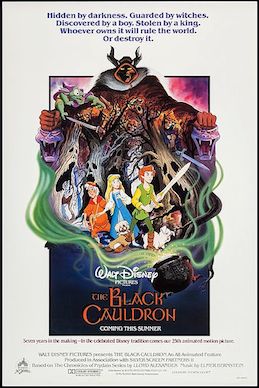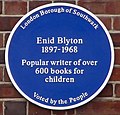Underrated: rated or evaluated too low; underestimated.
A-ha! I remembered! Here we are at last on ‘underrated’, as promised in my E is for Enthralling: The Fantasy and Sci-Fi Books that Got Me Hooked post:
Lloyd Alexander: The Chronicles of Prydain
They’re brilliant, and based on Welsh mythology. Never heard of them? Er… ever heard of the Disney film, The Black Cauldron? That’s not that surprising either. Taking its title from the 2nd book, yet loosely based on books 1 and 2, it was “the first Disney animated theatrical feature to receive a PG rating. It even had to be edited twice to avoid being released with a PG-13 or R rating” (IMDB). It’s popularly known as ‘the film that nearly finished Disney’. I’ll explain why in my ‘U for Underrated’ blog post.
See?
So let’s look at the film.
First, according to Wikipedia, ‘The Black Cauldron is notable for being the world’s first full-length animated feature film to incorporate the use of computer generated imagery in its animation.’ Well that sounds ok.
Second, Lloyd Alexander, the author of the books on which the film was based, had an interesting complex reaction to the film in an interview with Scholastic about his books:
“First, I have to say, there is no resemblance between the movie and the book. Having said that, the movie in itself, purely as a movie, I found to be very enjoyable. I had fun watching it. What I would hope is that anyone who sees the movie would certainly enjoy it, but I’d also hope that they’d actually read the book. The book is quite different. It’s a very powerful, very moving story, and I think people would find a lot more depth in the book.”
I have to agree there. But I think there are two reasons why the film wasn’t popular: the characters and story were too complex for the audience, and the story was too dark.
Because third: the story is very dark and this horrified just about everyone.

According to IMDb’s notes, after changes in Disney management during production, ‘new studio chairman Jeffrey Katzenberg screened the mostly-completed film and was appalled by its darkness’ and asked the producer, Joe Hale, to cut 10 minute of it. Joe and Roy Disney managed to cut 6 minutes that they thought would have little impact, But Katzenberg wasn’t happy. Despite their protests he ‘brought the film into an editing bay and began cutting it himself’. Joe Hale said that “eventually [Katzenberg] cut out about 12 minutes, which really hurt the picture.” The cuts were very clumsy and the Horned King wasn’t much of a villain once his habit of zombie-making was glossed over.
It was supposedly Disney’s attempt to gather teen fans, but it backfired.
According to animation artist Michael Peraza Jr., when Disney started having screenings for the public at the studio theater to gather their reactions to the rough cut of this film, he knew that the “un-dead” section would most likely be revolting to some in the audience who would not expect to see a bunch of rotted corpses slowly fermenting. When the film reached the “un-dead” sections close to the end of the film, the doors opened and a mother was angrily leaving with her two wailing children. She was followed by another, and soon there was a sizeable exodus of crying kids and upset parents fleeing from the theater. The un-dead sections were quickly cut from the film. IMDb
With its dodgy editing, changes in animators and producers, 5 torturous years in production and the loss of the grittier and more compelling scenes, it was a massive flop financially and critical reviews were mixed but often negative. It took years of nagging to get a VHS release (1998), then a DVD release (2000). Finally in September 2010, Disney released a 25th Anniversary Edition DVD, which we own, with one of the deleted sections featuring The Fairfolk. Wkipedia
And we own it because it is underrated. Yes, it could be a lot better, but you do get a sense of the story and it’s refreshing not to be confronted by the nauseating, weak ‘judge-me-by my-looks-because-I-don’t-have-any-brains, kiss-me-without-my-permission (or even my consciousness), save me, save me, I’ll-sacrifice-anything-for-you, marry-me-oh-my-hero’ Disney Princesses. It was a great book and the film does have a dark charm.
So should you get the chance, I recommend a watch.


